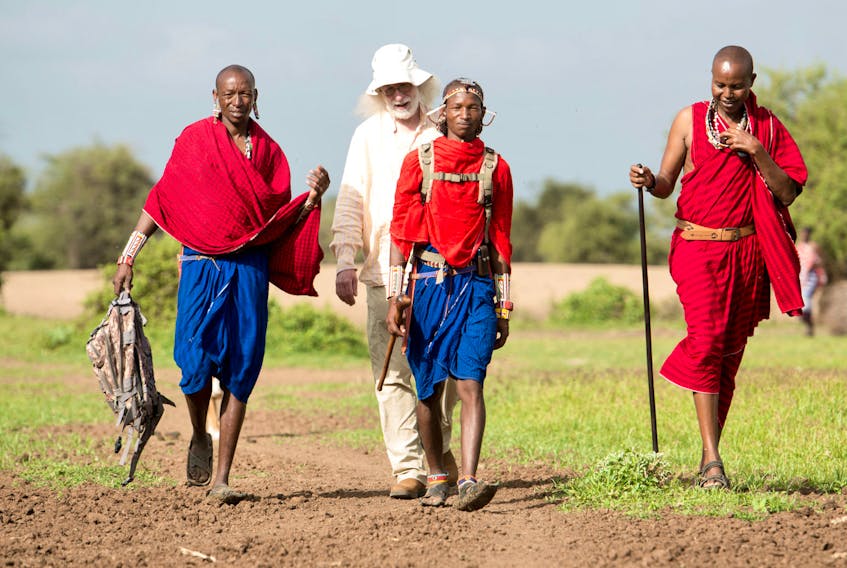Newfoundlanders hate coyotes.
That’s not just a general observation — it is a well-researched fact, documented through extensive research led by Alistair Bath, a professor and researcher at Memorial University who specializes in human dimensions of wildlife management.

“It’s the most negative attitudes that I’ve ever documented anywhere in the world,” says Bath, who has spent more than 25 years working with people and wildlife all around the world.
Seventy-one per cent of people on the island portion of the province either strongly dislike or dislike coyotes.
Sixty-nine per cent of Newfoundlanders do not agree that it is important to maintain populations of coyotes on the island for future generations. The same percentage disagree or strongly disagree with the statement, “whether or not I would get to see a coyote, it is important to me that they exist on the island.”
“Fear is a factor, for sure,” said Bath. “But when you see such strong attitudes, like existence – species have a right to exist – and they’re saying, ‘no way,’ it’s pretty powerful.”
“This is like, ‘wipe them out’. And even just, I believe it was yesterday on CBC Radio, I was hearing people saying, ‘you know, the moose numbers might be down’, well, a debate about where the moose numbers are, and what was mentioned? Well, ‘it’s because we’ve got this wild dog on the island, we need to get rid of it.’”
The coyote is a relatively small predator compared to the ones Bath usually works with, such as lions and cheetahs, yet the attitudes are more negative than anywhere else he has worked. Bath finds the attitudes troubling, but he hopes that, as a province, we can learn to coexist peacefully with the predator.
“In our province, we really need to learn from poorer places that have figured out how to share space with wildlife,” he says. “(We) need to reconnect people back to nature and build tolerance, or wildlife acceptance capacity.”
“Most people in most places are willing to share space and find coexistence values.”
When asked what might explain such negative views, Bath discusses the results, explaining that our residents have strong beliefs that coyotes cause significant damage to livestock, reduce hunting opportunities for big game animals, and negatively impact our outfitting industry.
From his research, Bath knows that a new predator to an area can cause negative attitudes as residents try to learn about the predator, but coyotes have now been on the island for 30 years, according to Bath’s data.
Last summer, a member of Bath's human dimensions in wildlife management team, which is recognized as one of the best in North America, did some research and found that attitudes haven't changed in those 30 years. Newfoundlanders’ views remain extremely negative toward coyotes.
“In our province, we really need to learn from poorer places that have figured out how to share space with wildlife. We need to reconnect people back to nature and build tolerance, or wildlife acceptance capacity.”
— Alistair Bath
Bath is quick to point out that coyotes do kill sheep, and for individual farmers, this can cause serious financial and emotional stress, and he says these conflicts need to be solved. He also adds that there was a human fatality caused by coyotes in Nova Scotia in 2009, but such an event is the only fatality in North America.
“You’re more likely to be struck by lightning seven times than attacked by a coyote,” he says.
With the attitudes in this province well-researched, Bath is hoping people here can learn from others around the world and become more accepting of the wildlife which surrounds us.
“What Newfoundland and Labradorians have to realize is the idea of not tolerating wildlife is really rare. In most parts of the world, people get along with wildlife, and get along with wildlife that actually do cause a lot more serious incidents than a coyote walking into St. John’s, or a wolf being seen in Goose Bay. Look, we are rare complaining about these things. We’re rare having such negative attitudes.
“We’re not as connected to the environment maybe as we often say verbally we are. Because we talk about we’re connected to the sea, we’re connected to the land, and maybe we’re not as connected as that farmer in northern Spain that knows wolves might take one of his sheep, but says, ‘you know, it’s okay, there’s room for both of us.’”
Bath just returned home to St. John’s after a series of international trips working with people around the world on wildlife management issues.
First, he went to Namibia.
“I was working with communities that tolerate and accept cheetahs occasionally killing their livestock and travelling through their farms,” he said.

Then he went to Kenya, where the Nairobi National Park exists in a traffic-filled Nairobi – a heavily-populated area, yet Bath “saw lions with the background of high rises, jackals, and lots of wildlife that remains a doorstep away from millions of people.”
“We’re far wealthier than many of the places where I work in parts of Africa. In Kenya, people still want lions. The Maasai struggle with lions on a daily basis, but they don’t want all the lions killed. The animals have a right to exist. So, I think we can learn a lot from different societies.”
After that, Bath was off to Romania to discuss creating the largest national park in central Europe, filled with brown bears, lynx, and wolves, and creating sustainable livelihoods for the communities in the area.
“A lot of my work is done in Europe, a land with 18,000 plus wolves, 14,000 plus brown bears, and a few more people than in our province, and residents not only tolerate the large carnivores but extremely value them and are proud to be living next to them.
“Here’s a place in Romania, which is incredibly poor, yet they want bears. They want wolves. They want lynx. They may see even some economic opportunities for tourism. But they also see that the animals have a right to exist.
“Our residents struggle where billions of others don’t,” he says.
Bath spent some time working in India, which has a population of 1.3 billion people, but also has tigers, wolves, lions, and elephants.
“It’s about sharing space,” says Bath. “They’ve just recently moved 100,000 people because the people believed it was important to move to expand the tiger reserve.”
“We know here in our province, and in our city even, a coyote comes into the town, we’ve had a lockdown of the schools, we’ve had police chase the coyote around and eventually kill it. We know when a coyote is seen on a trail or in the woods people get upset and phone the radio stations that, you know, coyotes have been seen.”
— Alistair Bath
Bath jokes about moving that many people out of St. John’s, and bursts into laughter, “I don’t think so, for any wildlife!”
“We know here in our province, and in our city even, a coyote comes into the town, we’ve had a lockdown of the schools, we’ve had police chase the coyote around and eventually kill it. We know when a coyote is seen on a trail or in the woods people get upset and phone the radio stations that, you know, coyotes have been seen.
“Meanwhile, in Vancouver there’s like thousands of coyotes inside the city. Same in Toronto. Same in Chicago. Same in many of the big cities across North America.”
Bath says that when he travels and tells people proudly that he’s from Newfoundland and Labrador, one of the first comments people make to him is that there must be plenty of wildlife here. He says his response is, “no, unfortunately not.”
“Because it’s not about habitat and space, it’s about people’s tolerance, and people’s willingness to share.”
He points to India, where there are multiple animals that have killed people, such as tigers and elephants, but notes that a big part of the culture is a respect for animals.
“So, the culture is important, and in our province, we really do have this strong connection to the sea and to our resources in our oceans, and I often wonder, how much does it translate though, into caring for those environments?”
Bath says he spends more time working abroad than he does here in the province, and that perhaps that’s an indication that other areas put more value on the research of human dimensions in wildlife management and interactions.
However, he does think we can learn from the work he has done in other countries, and perhaps by seeing how other people coexist with wildlife, we may become more tolerant.
“I think some of the things we can learn from other places is how to integrate this human dimensions and wildlife field into more effective decision-making about many of our resources in our province, and that’s a first step. Once we know how people feel about things, then we can start thinking of, how do we build tolerance?”
Learning from the Maasai in Kenya

There has been a steady decline in lions throughout Africa, and Kenya is no different.
While there are many reasons for this decline, Alistair Bath says one factor is the Maasai cultural practice of killing a lion with a spear to become a man—upon killing a lion, the man takes the name of a lion and is recognized within his society as a brave leader.
“Thus, to achieve lion conservation, it requires working with the Maasai in this area,” says Bath.
Bath works with a conservation team lead by Leela Hazzah to hire lion killers and have them become lion guardians.
“A successful lion killer has demonstrated many of the characteristics needed to effectively be a lion guardian,” says Bath. “He has demonstrated he can get close to a lion, thus able to identify lions, track lions, be strong enough within his community to be a leader, and able to control others from killing lions by sharing the benefits of lions.”
Bath says he sets out for a day in the field working with Maasai men as a team, “not armed with guns or spears, but with a GPS, and the indigenous knowledge that if a lion charges us, we are to stand our ground.”
It isn't long into their morning walks before they find lion tracks, which they follow until they see the lion or know where it is.
“We have taught the Maasai warriors to read and write, and so they stop and record the time and GPS location of where the lions are. Then, they call the shepherds from their community to advise where it is safe to graze cattle that day, and where they should not take their cattle.”
Bath says in this way they still fulfill their duties as a Maasai warrior for their village, and get paid a salary for their duties, something which also makes them attractive to the women of the village.
“Our lion guardians are very proud of what they do, sometimes standing on the Jeep to use telemetry to find the lions, even when we know there are none in that immediate area, but we see there are some women watching and thus perhaps an opportunity to impress.”
Bath says he has seen that people are now naming the lions. In the past several years of the Lion Guardians project, retaliatory killings have decreased to almost zero from previously well over 150.
“Lion conservation, like conservation of any wildlife, is about working with people to find solutions, understanding tolerance, and building opportunities for coexistence.”









